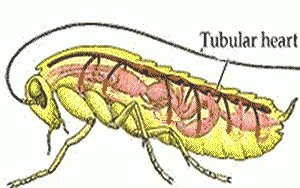The circulatory system of insects, like that of other arthropods, is classified as an open circulatory system. The blood, or hemolymph, is not contained in a closed system of vessels, but it freely circulates in the body cavities, reaching the organs. While in the vertebrates the circulation is organized in a complex system, in the insects the cavity haemocoel is in fact in contact with all the organs and the body sections, including the ribs of the wings. The hemolymph that flows into the haemocoel has a dual role, which we can compare to that in vertebrates is done by blood and by the lymph: the transport of nutrients and catabolites and the regulation of immune defenses. The transport of oxygen, in insects, is instead carried out by the respiratory system: hemolymph, apart from rare cases, is in fact free of hemoglobin. In particular need for hemolymph exchange are the antennal sensory receptors that must respond quickly to changes in environmental signals. Dealing with this problem are special accessory pulsatile organs at the base of each of these structures to channel the hemolymph into them. A large number of these accessory pulsatile organs may be present and are completely separate from the functioning of the dorsal vessel.
Depending on the types of insects, the haemocoel constitutes a single cavity or a system of cavities communicating with each other. Only in part the circulation takes place inside a vessel that is considered the heart.
This tube, open and branched anteriorly, is closed at the back and runs from the head to the abdomen. The posterior tract is called the heart, the anterior aorta.
The wall of the heart is made up of longitudinal circular muscle fibers, which divide the organ into communicating chambers that are separated by valves to ensure hemolymph flows in one direction. Muscles attached to the walls of each chamber undergo peristaltic contractions and force blood to flow forwards from chamber to chamber.
Blood circulation in most insects involves a caudal-cephalic vascular flow and a hemocelic flow in the opposite direction. The blood is pushed from the heart into the haemocoel, where it comes into contact with the tissues and internal organs, flowing into the back of the abdomen where it enters the heart. There is a phase of systole, in which the heart pushes the lymph towards the haemocoel, and one of diastole, in which the heart recalls the lymph to itself.
The rate of heart contraction varies between species and between stages of development within a species, making it impossible to generalize the rate throughout the insect orders. Environmental factors, such as temperature, affect heartbeat, with higher temperatures causing increased rates. At extreme high and low temperatures, the heartbeat may stop entirely. Like the accessory pulsatile organs, the contractions of the heart are regulated myogenically but can be influenced by nervous and endocrine stimuli.
Some recent studies (see: https://www.ncbi.nlm.nih.gov/pubmed/22609364 ) have found incredible structural, functional and even genetic similarities between the hearts of Episyrphus, Drosophila and human hearts, so much so that these animals hearts have been used to test new cardioactive or cardioinhibitory drugs.
Bibliography
- Slama K, A new look at the comparative physiology of insect and human hearts. J Insect Physiol. 2012 Aug;58(8):1072-81. doi: 10.1016/j.jinsphys.2012.04.014. Epub 2012 May 16.
- Polini Aldo, Manuale di entomologia applicata, Edagricole – New Business Media
